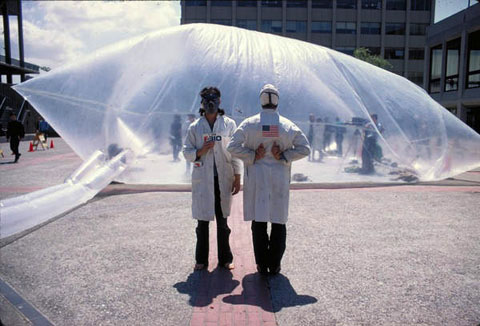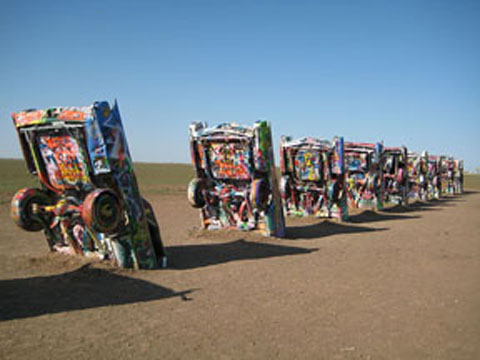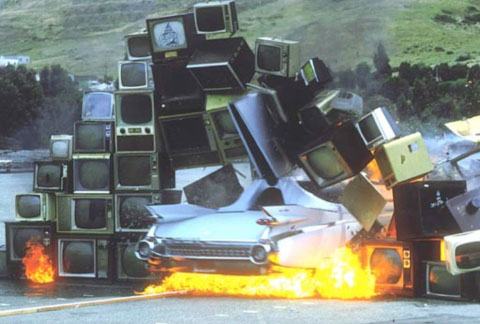Architecture as Basic Instinct: on 'Space, Land, and Time'
11 Sep 2010

IN THE ATMOSPHERE OF POSSIBILITY permeating the 1960s and 70s, "evading the demands of consumerism" was a customary practice of the counterculture, and Ant Farm--San Francisco's notorious architecture/video collective--embodied the very idea. It was Ant Farm's era--a fervid moment when utopian aspirations, from the sublime to the ridiculous, made their mark upon global consciousness. Ant Farm's oeuvre was decidedly American, an attempt to make mobile, nomadic architecture for future generations. In Laura Harrison and Beth Federici's new documentary on Ant Farm entitled 'Space, Land and Time: Underground Adventures with Ant Farm,' dozens of episodes of Ant Farm's epic escapades are shown. The film forges compelling links between the life of the artists and the contents of their extensive archive, combining history, verve and style in an expose of Ant Farm's complex, funny and emotive practice. Somehow the leftover spaces between architecture and media, which Ant Farm dared to live and to record, helps us understand on some level our own weirdly mediated relationship to the twenty-first century culture of today.
In looking at their work now, we'd do well to consider themes from the dense and exhilarating theory of Paul Virilio as if they were a backdrop to the spectacular aesthetics of an Evil Knievel. Ant Farm's unmediated performance strategies attempted enclosure of such critical gaps as the space between politics, art, land, memory, and popular symbols. Their art bears titles such as Cadillac Ranch, Media Burn, The Truckstop Tour, and The Eternal Frame--expressive of the breadth of popular culture with which they were involved. Roads and cars, sex appeal and commodity, networks, open space, auto-destruction and media formed the basis of many of their performance narratives. Likewise, the scale and daring of their events may also have inspired a tradition of Bay Area performance art similarly bent upon utilizing enormity, stunt activity, direct action, and endurance: Survival Research Labs stadium-sized machine marathons, Suzanne Lacy's large outdoor works with populations, and even the fantastic excursion of the "Lard Car" (see footnotes) to name a few. These resonate with Ant Farm's comic and controversial projects. Theirs was a practice which emphasized the process and social interaction of architecture over other issues and conceits of design; this really comes across in the film. 'Space, Land and Time' features numerous intimate and generous clips of Chip Lord and Curtis Schreier as well as earlier documentation of the late Doug Michels, 1967 graduate of Yale School of Architecture. Biographical details reveal that the collective eventually disbanded after their warehouse studio at Pier 40, San Francisco, burned down. The artists explain in their own words that their practice was "of a time" and that they had wanted to make countercultural architecture, avoiding "right angles." The film suggests that they owe the success of their work to group synergy and contextualizes Ant Farm within numerous avant-garde architecture practices and academic positions on radical architecture from across the globe.
Today, everything gets recorded. The documentation from which Harrison and Federici's film is largely contrived, however, is the remarkable physical proof of events long since finished. What is made clear in the film is that although pre-internet, Ant Farm's milieu was very aware of new technologies and the not-unrelated transformation of society and culture as their result. Television, long distance telephony, air travel and video, all informed Ant Farm's productions. They utilized media in all its related impact, from physical to psychological, in an effort to describe a lived modernity which was both part of the counterculture and an expression of its space. They used video to document and disseminate their ideas, which often took place well outside of the gallery frame of reference. Their architecture appears thus, as a kind of inscription on the lens through which they lived and worked. "Architecture," Schreier puts it, is not a "profession" but "a basic instinct." Rejecting subjugation of their souls to corporate firms, the artists joined together to design the future. This theme of course is a prevalent one today, as are many of Ant Farm's most treasured themes: peace, justice, environment and the impact of the road and car.
Having watched the 1950s evolve into the sixties, Lord and Schreier discuss the automobile and its symbolic freedom of speed, sex, and status. By 1969, cars were already gaining a negative reputation for their pollution and noise. The 'evolution of the fin' project, a basis of Cadillac Ranch, was a graphic examination of the Cadillac's tailfin evolution from the fifties to the seventies, while simultaneously a comment on America's number one popular status symbol (and an overt wasting of 10 big car bodies by submerging them in the Texas ranchland). Symbol, power, physicality, humor and horizon are balled up into this permanent work of art.

Ant Farm's experimentation had much grassroots scope, detailed in the film, with long tendrils into various subcultures. Their fascination with media resulted in the study of its networked form for purposes of art, a point of view to become deeply valued in video practices. They also played with the semiotics of media "event-scenes" (Wark, 2004). Legendary in it's own right, their Kennedy assassination re-enactment (The Eternal Frame) was performed in 1975. Recreating the tragedy as seen in the Zapruder footage and involving an unannounced occupation of public space (the oval at Dallas), Ant Farm blurred the life/art line. How would media influence architecture? Their love affair with the road, with bold symbolic elements of cultural imagery, inspired the team to create the Truckstop Tour, using an ordinary van customized with an inflatable solar driven shower, inflatable sleeping pod, a (very early model) Sony Video Portapak, and a clear plastic roof "dome" from which they could video record. The vehicle was designed as a nomadic habitat. With it they visited and set up at colleges as the 'Pneumads,' commenting on the growing mobile culture of the USA. These ideas paralleled Archigram's 'walking cities,' Suitaloon, and the work of numerous European groups. Truckstop Network, a drawing and concept evolving from the Tour, formalized a national network of "mini cities" (countercultural truckstops) where visitors could access tools and enjoy 2-way video communication.
Their real blending of art and technology emerges in their insistent use of video. Being able to represent their work through video was, they mention, almost as material as building construction. With video they could clear a space for the originality of their ideas, take notes, and create architecture. This pioneering use of the medium was linked closely to an understanding of art as a media event. Skip Bloomberg and Videofreex were, for example, artists who participated in recording The Eternal Frame for Ant Farm. An ad hoc Dallas audience is seen in the film shooting the performance with super-8 and Instamatic cameras. Arguably, Media Burn, performed in San Francisco in 1975 at the legendary Cow Palace--an ex-livestock hall--exists today only because of the documentary video camera. Many shots mimic those of televised news events of the time as drivers are seen close-cropped, arriving and getting in and out of their cars in full uniform--an image remarkably generated in "late sixties" news. Cameras also follow them into the arena. Beyond the sheer amazement at the Phantom Dream Car plowing through a wall of TVs is conception of the art as an event as entirely televisual. This idea, to record a three dimensional conceptual artwork electronically with the editing structure of 'news' is a kindred spirit, of today's blockbuster 'reality TV' in the commercial sector, but certainly of Survival Research and other ambitious, large-scale performance work in the art sector. Poignant are sequences of the two drivers, speeding along, from inside the cockpit of the auto. These images are imitative of interior shots from the Saturn and Apollo space missions.

◊
WORKS CITED
Wark, M. (2004) The Weirdly Tactical Media Event.
LINKS
Media Burn Retrospective
The Lard Car